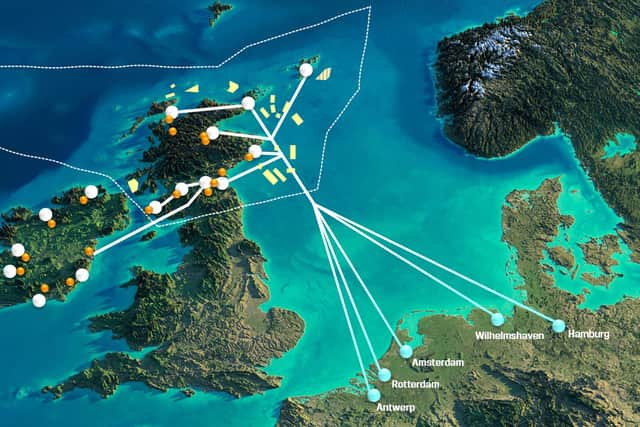Green energy: new purpose-built pipeline Scotland's best bet to export green hydrogen to Europe
and live on Freeview channel 276
Scotland's best bet to fulfil its goal of becoming a green energy export giant by 2045 would be to build a massive new undersea pipeline connecting it up to major European cities, a new report says.
A new report by the Net Zero Technology Centre (NZTC) published on Thursday (31 August) found Scotland's hydrogen production and export potential could be significantly boosted by developing a purpose-built pipeline through the sea.
Advertisement
Hide AdAdvertisement
Hide AdThis was the first phase of NZTC’s Hydrogen Backbone Link project, which explored what sort of hydrogen transport infrastructure was needed to help position Scotland as a frontrunner in the pan-European green energy export industry.
The project, funded by both the Scottish Government’s Energy Transition Fund (ETF) and industry partners, also looked into repurposing old oil and gas pipelines - but determined that a new purpose-built pipeline to Europe was the quickest route to market for Scotland’s green hydrogen.


The new pipeline could enable Scotland to meet up to 10% of Europe’s projected hydrogen import demand by the mid 2030s, the report said. With ongoing investment in additional infrastructure, it could maintain this beyond 2045, "helping Scottish Government meet its green export ambition and facilitating continental Europe’s industrial decarbonisation".
Actually building the Hydrogen Backbone Link could create upwards of 700 Scottish jobs, and enable enough new and existing green hydrogen projects to support a further 300,000 jobs in the green economy.
Advertisement
Hide AdAdvertisement
Hide AdThe report's recommendations to the Scottish government suggested that it "rapid acceleration of public and private investment" was needed to deliver the backbone pipeline, as well as continued investment in hydrogen and wind power to make sure the supply was secure.
According to Scottish Power, 'green hydrogen' is made when electricity from a renewable source like wind or solar energy is used to split water (usually from a freshwater source like a river) into its two components - hydrogen gas and oxygen gas - using a process called electrolysis. This involves a piece of equipment called an electrolyser.
The hydrogen gas can be transported to storage tanks via the sea, road, or pipelines, and can then be used for things like powering high temperature industry processes, refineries, and steel works; the food and drink industry; producing fertilisers for agriculture; plus powering shipping, aviation, rail, and long-range buses.
Using renewable forms of energy such as wind and solar can mean the entire production process results in zero carbon emissions, Scottish Power says.
A National Energy Storage Strategy would need to be put together, while the government would also need to work with its European partners to make sure policy and standards lined up across borders.
Hydrogen Backbone Link project manager Callum Milne said: “Scotland is poised to utilise its abundant natural resources, skilled workforce and proximity to an energy hungry market in north-west Europe but to maximise this, will take accelerated and increased government and industry investment, rapid development of infrastructure and cross border collaboration over the next decade.
“The Hydrogen Backbone Link (HBL) project is a key early enabler for this, providing cost-effective transportation to market for Scottish hydrogen producers and supporting the transition to a low-carbon energy system.”
Advertisement
Hide AdAdvertisement
Hide AdScottish Government Energy Secretary, Neil Gray, said they recognised the importance of developing hydrogen pipelines to unlock Scotland’s green energy export potential. "We want to work collaboratively with partners across Europe to advance infrastructure which ensures security of supply in Europe and positions the North Sea as a centre for low-cost hydrogen production."
“The Scottish Government supports the Hydrogen Backbone Link project because it gives valuable insight into the viability of repurposing or developing new pipelines," he continued. "This can help us understand any barriers where government support is required to unlock investment and realise Scotland’s export potential.”
Phase two of the project, which will examine the next steps needed to eventually start construction of the Hydrogen Backbone Link, is expected to get underway WHEN!!???
Comment Guidelines
National World encourages reader discussion on our stories. User feedback, insights and back-and-forth exchanges add a rich layer of context to reporting. Please review our Community Guidelines before commenting.
